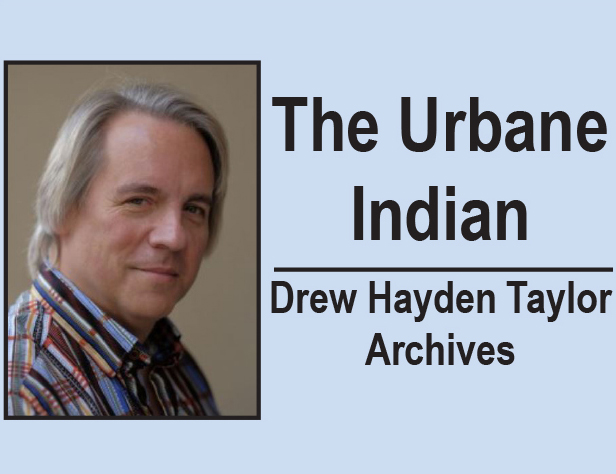
By Drew Hayden Taylor
Originally published in December 2012
There is probably no contemporary holiday so full of complex social and political issues for the modern-day First Nations person than Thanksgiving. Mine included.
For one thing, it makes me very confused. Like, what exactly is a pilgrim? Is it a group of people who follow a specific branch of Christianity like the Mennonites or Amish or the Elk’s club? Or are they a cultural or ethnic offshoot of a larger people, like the Doukhobors or Easter Island people?
I am a pretty well-traveled guy and yet, to this day, I have never met an actual pilgrim outside of another familiar and popular holiday known as Halloween. Are they an extinct people like the Homo Erectus or our own Beothuk, done in by all that rich turkey gravy, carbohydrate-heavy mashed potatoes, sweet cranberry jelly and apple pie? Or are they so integrated into our own society that they could be living right next to you and you wouldn’t even know it, like the Roma (formally known as the gypsies)? Like I said, it’s a complicated question.
Me, I try and take the holiday with a grain of salt. Just last Thanksgiving I was invited to three Thanksgiving dinners; one of the few benefits of being a 50-year-old orphan from a large extended family. But as I drowned myself in turkey and stuffing, I found myself ruminating over something that had happened earlier in the week.
I had been visiting a local farmer’s market, eager to scoop up some harvest bounty, when I noticed some familiar bunches of multi-coloured corn that was hung decoratively all over the room. I complimented the owners on the beauty of their Indian corn. The woman looked a little sheepish and said, with an embarrassed hush, “uh, actually we call it decorative corn now.”
In this age of political correctness, many things are being renamed to less offensive terms. The term ‘squaw” used to populate many maps and atlases, like Squaw Valley, Squaw River etc., but understandably one by one they are being hunted down and renamed. It just never occurred to me that Indian corn would be considered offensive. The odd thing is, it’s something so beautiful. I don’t mind it being called Indian corn. After all, we did invent it.
I could understand changing terms like the infamous Indian Burn, a nasty brutish act done primarily by bullies. For those uninitiated, you grab somebody’s wrist in both hands and twist in different directions, stretching the skin in between, leaving it red and sore. I have visited over a 130 Native communities across North America and have yet to find a nation or tribe that practices that as a cultural activity. Why it got named after us, I do not know. I’ve even asked a few Indians from India and they are unfamiliar with the activity too. It’s a mystery.
Indian giver is a no brainer. Yes occasionally we ask for our land back, but nobody seems to take us seriously.
But there are so many other terms that have been dumped in our laps but have nothing customarily to do with us. I ask you: Indian poker?! In practice, it’s a form of poker where you see everybody else’s cards except your own, placed in front of your forehead ( like a feather worn by ‘Indians’ I suppose), and try to guess by assessing all the cards available who has the highest card. Not surprisingly, it’s also known as squaw poker or Indian Head (which is a whole different argument).
Crayola Crayons used to have a colour called Indian Red. Not anymore. It’s been replaced with European pink.
Many are familiar with the term Indian Wrestling. That’s where two combatants lie on the floor facing opposite sides, and then link their legs together at the knees and try to flip the other guy over. Again, 130 communities, no evidence of this as a cultural activity.
Possibly it is in reference to those other Indians on the other side of the world but that didn’t prevent kids asking me when I was growing up if I Indian wrestled. When I refused to answer, they gave me an Indian burn. It was a horrible and vicious cycle.
Indian Summer is defined by the U.S. Weather service as unseasonably warm, dry weather, sunny and clear with the temperature above 21 C, after there has been a sharp killing frost. Maybe they could call it NAFNIP Summer – Native, Aboriginal, First Nations Indigenous People Summer. And of course there’s the great American city of Indianapolis, Indiana. Two names for the price of one. I am not sure if they have tried to rename them or not, but let’s face it, it’s only a matter of time.
